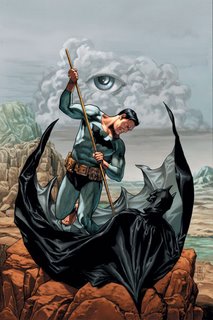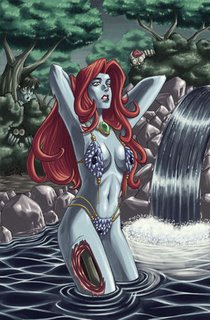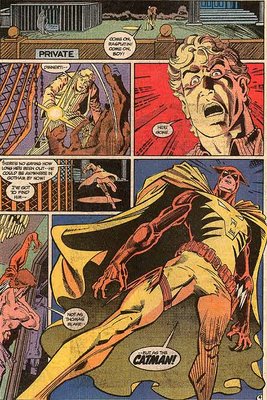
52 #30 (DC Comics) The company line is that all four writers involved with this weekly title write every single page as a team; that is, they all plot, they all script dialogue, and they all take a pass on every single page. Having not been involved in any of the meetings, I don’t know if this is true or not, but, this issue in particular, it doesn’t seem to be. Or, at the very least, certain writers’ fingerprints are much more evident on certain scenes than usual. The history of the Batman, for example, sounds an awful lot like what Grant Morrison told Newsarama.com in an interview was his vision of Batman’s personal history, and some of the lines read like they poured right out of Morrison’s finger tips (Not only the “Defeat me and the ten-eyed surgeons of the empty quarter will come to slice out your demons,” but even the offhand comment about the Joker being “this crazy, brilliant clown running around”). Likewise, the Question/Montoya segments read like those written by Greg Rucka, in part because he wrote a very similar story about the Huntress and the Question before, and in part because he’s the only writer who regularly uses the detective novel narration.

At any rate, this is a particularly rich issue of 52, from that masterpiece of a cover (muddied up by text as it is), proceeding through scenes featuring all members of the current Bat Family, and a weird new take on half-forgotten rogue The Ten-Eyed Man. In a mostly wordless sequence, artist Keith Giffen and Joe Bennett give us a “greatest hits” version of the personal tragedies endured by Batman, including the crippling of Barbara Gordon, his own temporary crippling at the hands of Bane, a scene that could come from Contagion, No Man’s Land or War Games, the revelation that his dead sidekick Jason Todd came back to life due to an inter-dimensional version of Superman punching along the walls of the “Heaven” dimension he was trapped in and thus altering the time stream, the death of Jack Drake and, finally, holding a gun to Alex Luthor’s head at the end of Infinite Crisis (One of these things is not like the other; can you guess which one?). Notice no mention of Cassandra “Batgirl” Cain anywhere in this issue, or Leslie Thompkins going over to the dark side for, um, whatever reason she suddenly became evil.
Aquaman: Sword of Atlantis #46 (DC) To keep this supposedly monthly series semi-monthly, a guest creative team is called in, sort of. Regular series artist Butch Guice draws the two-page prelude, while Phil Winslade draws most of the story (so well, in fact, that I wouldn’t mind he and Guice switching regular art duties, particularly if Winslade is the faster artist of the two). Regular writer Kurt Busiek gets top writing credit, but Karl Kesel as listed as “co-plotter.” The story is a sort of flashback that King Shark tells himself while training the new Aquaman, about his first encounter with the previous Aquaman. Or, as the title page puts it, this is “a tale of the classic Aquaman…in the days when he was king!” In it, Orin, Mera and Vulko visit a trading outpost, where King Shark has been biting people’s heads off—literally. Seeing how this story fits in with the newer high fantasy, “Swordfish and Sorcery” approach to the book Busiek has been taking since he took over, it does raise the question of why we even needed a new Aquaman. The classic one takes to the setting just as well as the new one.
Batman #659 (DC) After just four issues, the hot, new creative team of Grant Morrison and Andy Kubert apparently needed to take a break and, rather than letting this monthly miss shipping dates, DC drafted the creative team of John Ostrander and Tom Mandrake (responsible for the superlative series, The Spectre). I feel pretty bad for the pair. Individually, they’re great talents, and together they’ve produced one of the best DC series of all time, but following the industry’s hottest writer and hottest penciller is a thankless task. The first chapter of this story sets it up as a fairly unremarkable one. There’s a new bizarrely-themed rogue in Gotham named “Grotesk” who, in addition to not being able to spell very well, is cutting parts of his victims’ faces off and then burning them alive. Mandrake’s art is fantastic, some of the best of his career, and Ostrander’s story is serviceable, but a little cliché-ridden, and too pre-Morrison Batman. The most exciting thing about this title at the moment is the radical things Morrison is doing with the characters, but this could be just another issue of Paul Dini’s Detective Comics, or form any point in the last 20 years worth of Batman stories, really.
Batman/The Spirit #1 (DC) Good Thing About DC Having the Rights to the Spirit #1: It keeps Will Eisner’s work and character in the public’s consciousness. Good Thing About DC Having the Rights to the Spirit #2: This fun crossover. Writer Jeph Loeb has been letting me down quite a bit lately, but he’s in top form here, and this book fits nicely in with his best DC work (That is, everything with Tim Sale). Darwyn Cooke’s art is similarly spot-on; there’s nothing quite like a book so well illustrated that you have to pause every couple of pages just to admire the panel. The story is compact, but does everything you could hope such a crossover would do. Loeb, Cooke and inker J. Bone synthesize the best bits of Batman comics, the Bruce Timm-produced cartoon and even the old live action TV show for a sort of perfect Batman, and Eisner’s characters fit surprisingly well into this world (Cooke and Loeb do an especially fantastic job setting up the title sequence). The story? The two title heroes’ pipe-smoking police contacts, Dolan and Gordon, reminisce about the time their masked allies met one another. The two policemen attend a Policeman’s Benevolent Association ball in Hawaii. Spirit rogue The Octopus unites the Rogue’s Galleries of both Batman and the Spirit in an elaborate plot to bump off Dolan, Gordon and the rest of the country’s best coppers all at once, a plot that Batman, the Spirit and Robin must try to put the kibosh on. I was leery of an Eisner-less Spirit comic but, after reading this, I’m looking forward to Cooke and Bone’s Spirit #1.
Black Panther #22 (Marvel Comics) Any Marvel reader not currently reading Black Panther is missing out. I have some reservations about the title myself, particularly about its highly glitchy continuity and the ever-changing artists, but the “World Tour” story that wraps up here in a “Civil War” tie-in has been one great jumping on point after another. In this issue, Panther and Ororo visit Captain Britain to see if he’s down with joining their Coalition of Kicking Iron Man’s Ass or not, and then head to Washington D.C. to sit down with the president but, as has been the case with every meeting save the one with Namor, end up throwing down instead. Who with? Briefly with Jim Rhodes, a.k.a. War Machine, a.k.a. “The Black Iron Man” (Cool. I’ve been wondering whose side he was on). And then with Tony Stark, a.k.a. Iron Man, a.k.a. “The White Iron Man.” With both Namor and the Panther (and, thus, the respective countries) lining up against Stark, I honestly don’t even see how the final battle of “Civil War” is going to be anything but a rout. I guess we’ll find out in a few more months…

Dead Sonja, She-Zombie with a Sword #1 (Blatant Comics) Well, it had to happen sooner or later, didn’t it? I’m sure Dynamite Comics, who currently own the rights on Red Sonja comics and sell plenty of zombie-related comics due to their rights on Army of Darkness comics are kicking themselves for not thinking of this first. Hell, I know I am, and I don’t even own a comic book company. Writer Rob Potchak Jr. and Blatant certainly get props for coming up with a genius idea and title, but there’s nothing inside the book as remotely clever or well executed as the title, logo and covers (they even have several variant covers, ala Dynamite’s Red Sonja books). The black and white art, by Owen Gieni, Ap. Furtado and Remy “Eisu” Mokhtar (that’s Eisu’s cover pictured) is all decent, and done in a fun, loose style, but few of the jokes are very funny. Of course, seeing as the sixth page of this 48-page comic includes a rape-related joke, it’s hard to find anything that follows even remotely chuckle worthy, as that’s a pretty reprehensible thing to include in any story, let alone one as unserious as this.
Green Lantern #15 (DC) Attention, Justice League fans! This issue of Green Lantern features the first appearance of the new Justice League line-up that’s currently being teased on covers of the JLoA monthly. You know, Black Lightning, Arsenal, Hawkgirl, Vixen, Red Tornado—those guys. Now, they look pretty cool all lined up and posing like that in the snow, but you know where a better place to introduce the team might have been? Their own title, which has yet to formalize the line-up (Four issues in, writer Brad Meltzer is still gathering the team together). They’re in the book for the same reason just about everyone seems to be in it these days—to take down rogue superhero Hal Jordan. Also vying for the honors are a mind-controlled Global Guardians, the faceless hunters of Saturn and the Rocket Red Brigade. Johns throws all kinds of good craziness at readers this issue, including another teasing look at the growing Sinestro Corps (I like how their home base resembles a Santa’s workshop of evil here). My only real complaint with this particular issue is Jordan’s comments about Tasmanian Devil being gay and, during their time on League factions, harboring a crush on Jordan. Our hero blasts him with his ring and quips, “I told you before, Taz. You’re not my type.” Can’t a gay were-Tasmanian devil attack a straight superhero without the straight superhero assuming he’s making a pass at him? It’s in character with Johns’ new, Guy Gardner-ified, post-Rebirth Jordan, but it’s still pretty ugly.
The Immortal Iron Fist #1 (Marvel) I know precious little about Danny “Iron Fist” Rand, other than the fact that his name makes me snicker almost as much as his goofy-ass costume, but the three first names on this creative team are enough reason to check out just about any comic book: Brubaker, Fraction and Aja. The issue itself gives plenty more reasons to check out #2, including Aja’s gorgeously sketchy and dark art (and neat little way of highlighting kung fu action) and Brubaker and Fraction’s terse narration and widening the point of view to make this a story about a dynasty of Iron Fists, not just Danny. Now, about that school picture of Luke Cage…
Stan Lee Meets Doctor Doom #1 (Marvel) The Lee-written lead-ins on this series of one-shots have been mostly hit-or-miss, but this one’s a definite hit. At home working on a model of a ship (I love how Lee presents himself as this old guy who putters around on different hobbies like baking, biking and miniature ship-building all day) one day, he’s summoned to Latveria by Victor Von Doom, who’d like to have a little chat with him: “ I am displeased by the manner in which I am portrayed in American comic books.” He earns his freedom by pointing out that he’s just a guy who cameos in superhero movies. The art on this piece, by Salvador Larroca, is just drop dead gorgeous—Latveria and its doombots have never looked so awesome. Back-ups include a Jeph Loeb and Ed McGuinness story about Lee once again goading his creations into playing their roles and a classic Fantastic Four story by Lee and Jack Kirby. That’s a lot of good comics reading for just $3.99.
Superman/Batman #30 (DC) Penciller Ethan Van Sciver is a force to be reckoned with. He’s just an incredibly gifted artist, one who’s capable of drawing just about every DC character very well, and rendering some of them so well it’s downright transcendental. Like Green Lantern Kilowog, who looks like some sort of humanoid rhinoceros, with a touch of extinct giant mammal to him. Or Plastic Man, whom Van Sciver gives a strong sense of realism and three-dimensionality, which makes his cartoon-ish shape changing seem all the more impressive. When this Plas is at rest, he seems as real as Batman, Alfred or Superman, but when he stretches a limb, all the detail and line-work fades away, and you can see him stretching his molecules (Page 18, panel 2—tell me that isn’t one of the best Plastic Man panels you’ve ever seen; I dare ya!). Van Sciver’s skills are, unfortunately, a huge liability to a monthly comic book like Superman/Batman should be, as he draws too slowly to keep a monthly schedule. So, what’s he doing as the regular artist on this series? I have no idea. If you’ll allow me to engage in a bit of armchair editing here, if it were up to me, I’d get Van Sciver on an All-Star book or working on an arc to be fit into one of the Confidentials or Classifieds, where he can take his time drawing and the finished product can be fit in whenever there’s an open slot, rather than having him hold up what should be a top seller month in and month out for DC.
Now, back to the issue at hand, this issue of Superman/Batman, we’re in part three of the Bunch of Crazy Shit Happens For No Reason storyline. Superman fights Kilowog, but whatever seems to be controlling Big K’s mind is starting to get into Supes’ too. Meanwhile, Lex Luthor calls Batman in to steal something from the Fortress of Solitude that could be the key to unraveling this mess, and sets him up with Plastic Man (in his first “One Year Later” appearance, Plas fans). For some reason, Batman acts like he barely knows Plas and as if they weren’t on the Justice League together for, what, 95 issues or so? Plas also mentions that he has a son now, which puts the Joe Kelley stories about Plas as a deadbeat dad back into continuity, after Kyle Baker went to the trouble of knocking them out of continuity. You know, I don’t mind Plas being a reformed thief, but I really don’t like the idea of him being a reformed deadbeat. Oh well, I guess we’re just lucky he survived Infinite Crisis and hasn’t been super-punched out of continuity.
Teen Titans #41 (DC) I could have sworn “Titans Around the World” concluded last issue, but I guess not, as the Titans are still fighting Bombshell this issue. Jericho is back from the dead and with a better haircut and costume, and he narrates the issue, as the team takes on Bombshell and her freelance military specialists, who all wear Nazi-style helmets for some reason (To let us know they’re the bad guys, maybe…?). Bombshell gets her butt kicked, naturally, and also gets her top shredded to the point that it’s barely functional. The only other noteworthy story beats involve a surprise guest appearance by Sarge Steel and Agent Diana from the pages of Wonder Woman (no idea where this fits into her story, though), a light bulb going off over Robin’s head about how to resurrect Superbly and Miss Martian and Jericho officially joining the team. The art is by guest painkillers Pico Diaz and Ryan Benjamin plus
Confidential to Deathstroke: There’s no “N” in the word “kid.” Jeez, I thought your special implants gave you the ability to utilize 90-percent of your brain, and yet you can’t spell simple three letter words? How on earth do you ever hope to defeat the Teen Titans?












